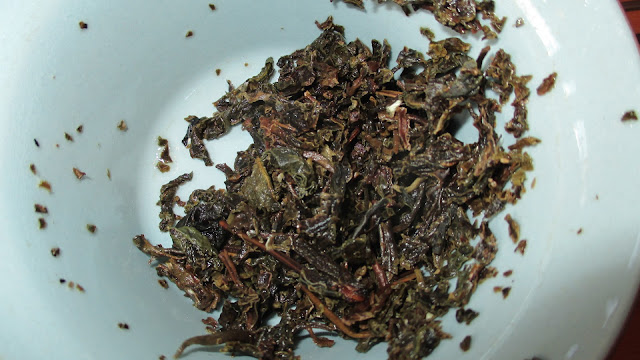However, before we get to the tea I want to highlight something first.
Brick Tea
This tea "serves both for drink and food. The Chinese carry on a great trade in it, but never drink it themselves. In the tea manufactories, which are for the most part in the Chinese government of Fokien, the dry, dirty, and damaged leaves and stalks of the tea are thrown aside, they are then mixed with a glutinous substance pressed into moulds, and dried in ovens. These blocks are called by the Russians, on account of their shape, brick tea." The Kalmucks and inhabitants of Siberia, "take a piece of this tea, pound it in a mortar made on purpose, and throw the powder into a cast iron vessel, full of boiling water, adding a little salt and milk, and sometimes mixing flour fried in oil. This tea, or broth, is known by the name of Satouran." This brick tea serves also instead of money in the dealings of these people. - Timkowski's Mission to China.
This fascinating quote comes from the Dublin Penny Journal, Vol. 2 (89), p. 296, which was published in 1834. Digging around, George Timkowski turns out to have written an account of his travels to Russia and China, which was published as "Travels of the Russian Mission through Mongolia to China, and Residence in Peking, in the years 1820-1821." Although I like old books and old travel narratives, that is really not the point here - this is a post about what we call today pu-erh (puerh) tea. I love puerh tea, and despite it being one of the more confusing "types" of tea, I love drinking and delving into its history and nature.
Above is a photo of some of the puerh we have stored and aging. Cooked, raw - shou and sheng. But right now, I'm fascinated with the above quote; what is this tea described by Timkowski? My understanding of puerh - a brief, incomplete one at that - is that it originated partly as a result of trade requirements on the Silk Road. Putting 10lbs of fresh tea on a camel's back and trekking from China over the Tibetan Plateau towards the West would not prove to be economical. The tea would be too bulky, and by the time it got anywhere, it would be stale and probably not taste well. Taking the fresh leaves, however, and pressing them tightly together into "bricks" was developed as a result, proving to be an easy, economical, and efficient way to transport large quantities of tea West. That is what is described above, but it is certainly not what I know of as puerh! So, what is it? I can't find any mention or discussion of this type of tea or hei cha. Was it the original bullet proof coffee? I would be really interested in learning more about this tea and what the glutinous substance was. It just goes to show, my lack of knowledge if far greater then my knowledge of tea. But, on to the tea that is subject of this post - a 2002 Six Famous Tea Mountain You Le Gu Cha.
2002 Six Famous Tea Mountain You Le Gu Cha
Here is what I (think I) know - the Six Famous Tea Mountain Factory was formed in 2002 by a former Menghai Tea Factory manager Ruan Dian Rong. This You Le Gu Cha may or may not be their first puerh - I'm sure they produced several different puerh's during their first year. However, it is from their first year in production, which makes it very exciting. From the photos, it is easy to tell that it is a sheng by the color of the leaves after being steeped.
I'm a believer in lots of tea, quick steeps. Using 185 degree water, I did steeps at 15 seconds to 30 seconds. All turned out beautifully, and this tea was a pleasure to drink over the afternoon. With a classic sheng aroma of deep raw earth and aged, suede leather smells the liquor had a light mouth feel that primarily tantalized the middle and back of the mouth. A touch of sour was noted, with a slight oilish coating over the tongue, I really enjoyed this raw puerh, and I noticed an immediate cha qi (or caffeine hit) from the tea. Overall, a perfect tea for a busy Sunday afternoon at work.
The raw leaves broken away from the beeng cha.
After the initial rinse, freshened but still closed and tight.
The first steeping - ~20 seconds.
The leaves starting to open - note the green color of a true sheng.
Fourth steeping - ~20 seconds again. Fully open, this puerh proved to be delicious from first to last steeping.
The leaves fully open - they almost look like fresh green leaves even after 13 years of aging!







No comments:
Post a Comment